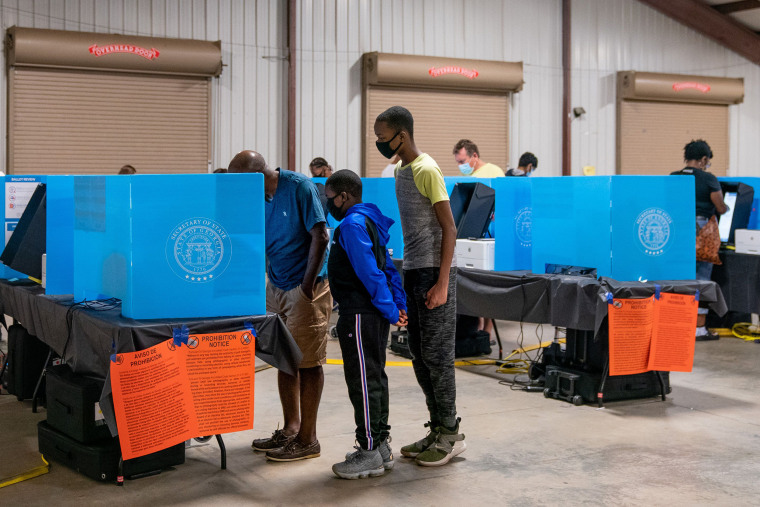We’re days away from the midterms and that means much of the political establishment is hyper-focused on the group most likely to tip the outcome: suburban voters. The majority of the nation’s population now lives in the suburbs, making these regions the most significant battleground in politics today.
Groups who do not conform to the conventional image of the suburban dweller are now more likely to live in the suburbs than in the city: the poor, immigrants and middle-class Blacks.
Within the suburbs, journalists have argued that women “are seen as the most prized and persuadable bloc” because they have demonstrated a willingness to shift parties depending on the issues. Right now, downturns in the economy and abortion bans are competing for their attention.
But politicians pandering to suburban women need to make sure they aren’t making the wrong assumptions about them. Too often terms like “suburban women” and “soccer moms” are stand-ins for “white women.” The reality is that the suburbs are diversifying and it is a broad range of suburban voters who will decide the outcome of the midterms.
I study the suburbs in my work as a sociologist. My research identifies three recent trends contributing to the suburbs’ status as an important new fault line in political life. Groups who do not conform to the conventional image of the suburban dweller are now more likely to live in the suburbs than in the city: the poor, immigrants and middle-class Blacks.
How did we get here? First, poverty is drifting from central cities to the suburbs. Our most reliable data is from 2010, at which point the majority of the country’s poor, 55%, resided in the suburbs. The federal government’s decision to raze public housing in cities and replace it with housing vouchers contributed to the migration of poor people — more often than not to distant suburbs — as they searched for areas where landlords were willing to accept their vouchers.
Moreover, the cost of an apartment in the city nowadays is typically out-of-reach even when poor families factor in their vouchers. At the same time, as I explain, some working-class suburbanites became poor in place, slipping into poverty during the 2008 Great Recession that was precipitated by the housing bubble.
Shifts in immigration patterns also changed the composition of the suburbs. In the 2000s, a stunning 30% of suburban population growth was attributed to immigrants. Increasingly, immigrants are settling in the suburbs upon arrival and skipping over the city as the first step in their assimilation into mainstream society. Partly that’s because many of the low-skilled service jobs in places that need to rent lots of space, like warehouses and factories, have found it more affordable to relocate there.
The ethnic and racial makeup of immigrants today has also changed. Their geographic diversity is largely due to the Hart-Celler Act passed by Congress in 1965, which eliminated restrictions on immigration from Africa, Asia and southeastern Europe imposed under the National Origins Act of 1924. By 2019, the majority of immigrants to the U.S. came from five countries: 24% from Mexico, 6% from India, 5% from China, 4.5% from the Philippines and 3.5% from El Salvador. The majority of them, 51%, live in the suburbs.
Finally, the reverse migration of Black people from the North to the South contributed to the majority of the Black population (51%) residing in the suburbs. From 1910 through the 1970s, over 6 million Black people left the South for the North. But starting in the 1970s, a reverse migration — part of an overall U.S. population shift toward the South and West — coincided with the emergence of a stable, Black middle class comparable to its white counterpart in terms of education, occupation and income.
A suburban home signaled that this group had achieved the American Dream, so the suburbs of four Southern cities — Atlanta, Washington, Dallas and Houston — became popular destinations for the Black middle class.
The political effects of these changing suburban dynamics will be on display in Tuesday’s midterms. In Georgia, for example, an influx of people of color into the state’s suburbs have moved the state from ruby red to trending blue and could push Democratic Sen. Raphael Warnock over the top in his re-election bid. A strong dislike for Republican Senate candidate Herschel Walker is also motivating some suburban Republicans to split their ticket, voting for Brian Kemp, the Republican incumbent, for governor and Warnock for Senate.
A white, monolithic conception of the suburbs is no longer accurate. That means Republicans who want to win in the long term, not just the next election or two, will need to abandon a way of life that’s a relic of the past and devise a durable strategy to attract suburbia’s newest residents.
At the same time, Democrats can’t take diverse, suburban voters for granted, as recent polling shows a Republican lead in the upcoming midterms. For either party to succeed in this changed political battleground, they must recognize the suburbs’ new dynamics and connect with these voters accordingly.
